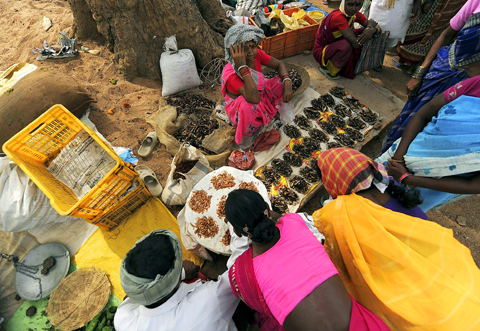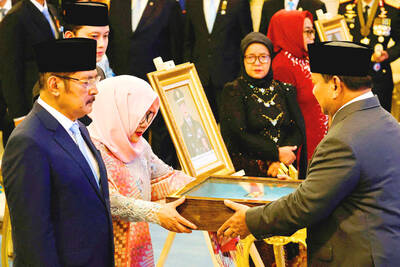Natural cosmetics, lime grass insecticides, gooseberry candy, herbal medicines and honey are among new weapons deployed by India in its fight against Maoist insurgents.
They are produced by villagers in state cooperatives in Maoist-hit Chhattisgarh, providing income that the government hopes will help keep the workers out of the ranks of the rebels and their supporters.
India’s war against Maoist insurgents cannot be won with guns alone, experts say — economic development and solutions to the grievances of rebel sympathizers are needed.

PHOTO: AFP
Last month’s massacre of 76 Indian policeman by the rebels touched off a national debate about the need for “hearts and minds” efforts in insurgency-hit areas to accompany a nationwide security offensive launched last year.
The Chhattisgarh cooperatives are part of an attempt by the state to regain influence in the 45,000km2 of forests at the heart of what is known as India’s “Red Corridor,” where the rebels hold sway.
“We will not join the Maoists because we have money in our pocket and food in our belly,” 18-year-old Sharda Mandavi said as she busily ground herbs.
Around her, men and women mostly aged 16 to 19, in aprons and face masks, worked eight-hour shifts in spartan tin-roofed enclosures set up by the state’s forest department.
“These kids are so busy that they cannot even think of joining the insurgency,” said forest warden U.S. Thakur in Jabarra, 165km from state capital Raipur.
In the villages in the area, home to the Gond, Muria, Maria or Halba tribes, Maoist recruiters are constantly on the look out for jobless or disaffected potential cadres. Nocturnal visits are common, say locals.
One supervisor at the reprocessing center in Dugli, who was abducted last month by the rebels but was freed when he refused to join the movement, said the project is helping to fill a void.
“We are doing what the police cannot do with guns and bullets,” he said, asking not to be named for security reasons.
“These men and women are now fighting back with candies, herbs and honey and in the process we are also protecting our forests from the Naxals [Maoists],” he said.
Chhattisgarh’s top forest conservator R.K. Sharma said in Raipur that 8,500 such facilities were operating in troubled areas to try and “wean away young men and women into skilled jobs.”
The projects under the Joint Forest Management (JFM) scheme have paid dividends of 584 million rupees (US$12.9 million) between 2000 and 2008 to local villages, according to records and supervisors.
Villages earn up to 30 percent of the profits from the sale of the forest products in government shops and other retail chains nationwide. Money is also shared with settlements that do not have resources.
Experts warn, however, that isolated projects such as Chhattisgarh’s JFM are not enough to fight the Maoists in states where they have entrenched support that feeds off resentment at state corruption and incompetence, as well as land disputes.
“Primary healthcare, education, agricultural reforms and tenancy laws need to be improved,” said Maoist expert Mallika Joseph from the Institute of Peace and Conflict Studies, a New Delhi-based private think tank.
“It is a challenge, but it is doable. The Maoists cannot achieve them,” she added.
In addition to the implementation constraints of development projects, the government also faces a dynamic enemy.
“Naxals still come to us and say ‘we will pay you more if you join our fight,’’ said a 21-year-old man at the Dugli facility. “But please do not mention our names as we are scared and besides the police are powerless to give us any protection.”

James Watson — the Nobel laureate co-credited with the pivotal discovery of DNA’s double-helix structure, but whose career was later tainted by his repeated racist remarks — has died, his former lab said on Friday. He was 97. The eminent biologist died on Thursday in hospice care on Long Island in New York, announced the Cold Spring Harbor Laboratory, where he was based for much of his career. Watson became among the 20th century’s most storied scientists for his 1953 breakthrough discovery of the double helix with researcher partner Francis Crick. Along with Crick and Maurice Wilkins, he shared the

OUTRAGE: The former strongman was accused of corruption and responsibility for the killings of hundreds of thousands of political opponents during his time in office Indonesia yesterday awarded the title of national hero to late president Suharto, provoking outrage from rights groups who said the move was an attempt to whitewash decades of human rights abuses and corruption that took place during his 32 years in power. Suharto was a US ally during the Cold War who presided over decades of authoritarian rule, during which up to 1 million political opponents were killed, until he was toppled by protests in 1998. He was one of 10 people recognized by Indonesian President Prabowo Subianto in a televised ceremony held at the presidential palace in Jakarta to mark National

US President Donald Trump handed Hungarian Prime Minister Viktor Orban a one-year exemption from sanctions for buying Russian oil and gas after the close right-wing allies held a chummy White House meeting on Friday. Trump slapped sanctions on Moscow’s two largest oil companies last month after losing patience with Russian President Vladimir Putin over his refusal to end the nearly four-year-old invasion of Ukraine. However, while Trump has pushed other European countries to stop buying oil that he says funds Moscow’s war machine, Orban used his first trip to the White House since Trump’s return to power to push for

LANDMARK: After first meeting Trump in Riyadh in May, al-Sharaa’s visit to the White House today would be the first by a Syrian leader since the country’s independence Syrian President Ahmed al-Sharaa arrived in the US on Saturday for a landmark official visit, his country’s state news agency SANA reported, a day after Washington removed him from a terrorism blacklist. Sharaa, whose rebel forces ousted long-time former Syrian president Bashar al-Assad late last year, is due to meet US President Donald Trump at the White House today. It is the first such visit by a Syrian president since the country’s independence in 1946, according to analysts. The interim leader met Trump for the first time in Riyadh during the US president’s regional tour in May. US envoy to Syria Tom Barrack earlier